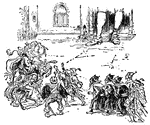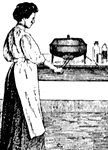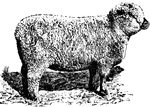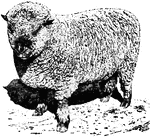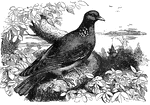
Battle of Cedar Mountain
"Gordon's and Crawford's Brigades driving the Confederate forces from the woods at the Battle of Cedar…
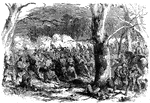
Storming of Fort Donelson
"Storming of Fort Donelson- decisive bayonet charge of the Iowa Second Regiment on the Confederate intrenchments…

Camp Dennison
"Camp Dennison, sixteen miles above Cincinnati, on the banks of the Miami River, General Cox commanding-…

Military authorities
"The military authorities at Washington, D. C., examining passes in 1861. This scene was of frequent…

Seventy-ninth Regiment
"Taking away the colors of the Seventy-ninth New York Regiment for insubordination and mutiny, Washington,…

Fort Thompson
"View of New Berne, N. C., from the interior of Fort Thompson after its capture by the Federal forces-…

Combat at Yazoo River
"Desperate naval combat between the Confederate iron-plated ram Arkansas and the Federal gunboat…

Battle of Savages Station
"Battle of Savages Station. Brigadier General Smith's division hotly engaged with the enemy, at noon,…
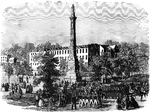
Pulaski Monument
"Review of Confederate troops on their march to Virginia, in front of the Pulaski Monument, Monument…

Cavalry of General Banks
"A reconnoitring detachment of General Banks's cavalry, Hyattstown, Md., in the distance. There are…

Camp Wool
"Camp Wool, two miles from Fort Clark, Hatteras Island, occupied by Hawkins's Zouaves, Ninth Regiment,…

Battle at Dam No. 4
"Battle at Dam No. 4, Potomac River, between Butterfield's brigade and a large Confederate force. A…

Battle of Munfordville
"Battle of Munfordville, Ky., Sunday, September 14th, 1862- the Confederates charging through the abatis…

Masquerade of War
"The Masquerade of War. Ingenious method of disguising the masts and hulls of Commodore Porter's morter…
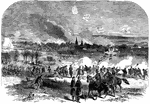
Bombardment of Fredericksburg
"Bombardment of Fredericksburg, Va., by the army of the Potomac, commanded by General Burnside, Thursday,…

Port Hudson
"The advance of Port Hudson. The baggage train of General Augur's division crossing the Bayou Montecino,…
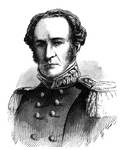
General George Stoneman
"General Stoneman, born in Busti, Chautauqua County, N. Y., August 8th, 1822, was graduated from the…
!["The Plantation Police, or Patrol, was an institution peculiar to the Slave States. It was a semi-military organization, raised and supported by the planters, but recognized by the old State authorities. Their principal duty was to visit the various plantations and patrol the roads at night, arresting all [African Americans] and others not having proper passes. The war, the President's proclomation, and the actual possession of most of the State of Louisiana by the Federal authorities, rendered these patrols doubly rigorous. Some of the [African Americans] submitted reluctantly. The [African American] in the foreground is a speciman of this class. He seems to yield to the superior force of a tottering power, satisfied that his day is at hand; others show the obsequious, submissive stamp- the [African American] satisfied with his lot if he is clothed and fed."— Frank Leslie, 1896](https://etc.usf.edu/clipart/11600/11643/plant-police_11643_mth.gif)
Plantation Police
"The Plantation Police, or Patrol, was an institution peculiar to the Slave States. It was a semi-military…

Confederate rams
"Confederate rams from Charleston Harbor attacking the Federal blockading squadron, January 31st, 1863.…

Bogue Island
"The Federal siege works on Bogue Island, N. C., erected for the reduction of Fort Macon. Our sketch…
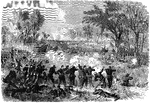
Battle of Chancellorsville
"Battle of Chancellorsville, Sunday, May 3rd, 1863. General Hooker repulsing the attack of the enemy.…

Cumberland Army
"The army of the Cumberland- Wilder's mounted infantry passing a blockhouse on the Nashville and Chattanooga…
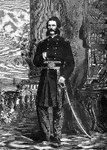
General Lafayette C. Baker
"General Baker, Chief of the United States Secret Service, born in Stafford, Genesee County, N. Y.,…

Cutting Levees
"Cutting the levees near the state line of Louisiana and Arkansas, twenty miles above Lake Providence,…

Battle of Coal Harbor
"Grant's Campaign in Virginia. The Battle of Coal Harbor, June 1st, 1864. On the 1st of June the Confederates…

Federal Prisoners
"Federal cavalry covering the escape of Federal prisoners from Libby Prison, Richmond, Va. The feeling…

Battle of Grand Coteau
"Battle of Grand Coteau, La., November 3rd, furious attack on the Sixtieth Indiana, Colonel Owen. On…
!["Capture of Fort De Russy, La., on the 14th of March, 1864, by the Federal forces under General Andrew Jackson Smith. This fort was captured, March 14th, 1864, by the Federal forces under General A. J. Smith. The expedition left Vicksburg on March 10th, landed at Summerville, La., on the 13th, and marched to Bayou Glace, where General Scurri's Confederate brigade had been encamped, which fled on the approach of the transports, leaving considerable camp equipage and commissary stores. General Smith pushed forward to Yellow Bayou, where strong fortifications had been erected; but the Confederates again fled. As he came up the enemy was pressed, and some skirmishing occurred, resulting in the capture of several prisoners and a small wagon train. At daylight the entire command started for Fort de Russy, twenty-eight miles distant, hotly pursued by General Dick Taylor, who hoped to save the fort; but Smith had the lead, and at four o'clock in the afternoon the Third and Ninth Indiana Batteries opened on the fort, which replied vigorously with three of its heaviest guns. The cannonade continued an hour, when General Smith ordered the First and Second illinois Regiments, Sixteenth Corps, under General Mower, to charge the enemy's rifle pits and storm the fort. The Eighty-ninth and One Hundred and Nineteenth Indiana and Twenty-fourth Missouri Regiments charged over deep ditches and a thick abatis in the face of a galling fire, and within twenty minutes after the order was given the [African American] sergeant of the Fifty-eighth Illinois Volunteers planted the American flag upon the enemy's works."— Frank Leslie, 1896](https://etc.usf.edu/clipart/11700/11750/derussy_11750_mth.gif)
Fort de Russy
"Capture of Fort De Russy, La., on the 14th of March, 1864, by the Federal forces under General Andrew…
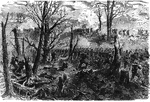
War in Tennessee
"The war in Tennessee. Capture of Mission Ridge, near Rossville, by General Thomas, November 25th, 1863.…
!["Siege of Petersburg- the Ninth Corps charging on the enemy's works after the explosion of the mine, July 30th, 1864. Immediately after the explosion of the mine a hundred cannons opened along the Federal front, and at half-past five the Ninth Corps charged, carrying the fort with a part of the line on each side. The Second Division, which was in the centre, advanced and carried the second line a short distance beyond the fort, and rested, holding ground with the utmost determination. It was at the time the [African American] Division, under General White, was pushed forward and ordered to charge and carry the crest of the hill, which would have decided the contest. The troops advanced in good order as far as the first line, where they received a galling fire, which checked them, and although quite a number kept on advancing, the greater number seemed to become utterly demoralized, part taking refuge in the fort, and the remainder running to the rear as fast as possible. They were rallied and again pushed forward, but without success, the greater part of the officers being killed or wounded."— Frank Leslie, 1896](https://etc.usf.edu/clipart/11800/11856/petersburg_11856_mth.gif)
Siege of Petersburg
"Siege of Petersburg- the Ninth Corps charging on the enemy's works after the explosion of the mine,…

Fifth Corps
"The siege of Petersburg- the Fifth Corps awaiting the order to advance, July 30th, 1864."— Frank…

Delaine Merino Sheep
A pair of Delino merinos. They are more suited to be used for mutton, but their wool is of lesser quality…
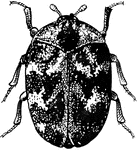
Adult Common Carpet Beetle
An adult common carpet beetle, a small grayish or black beetle belonging to the order Coleoptera.

Common Carpet Beetle Pupa
Pupa of the common carpet beetle, a small grayish or black beetle belonging to the order Coleoptera.

Common Carpet Beetle Larva
Larva of the common carpet beetle, a small grayish or black beetle belonging to the order Coleoptera.

Common Carpet Beetle Larva
Larva of the common carpet beetle, a small grayish or black beetle belonging to the order Coleoptera.

Passeres
An assortment of passeres, one order of birds. The legs, feet, and talons are generally smaller than…

Ascent of Round Top
"Visit of Union and Confederate officers to Gettysburg, the ascent of Round Top."— Frank Leslie,…

Fort Fisher
"First assault upon Fort Fisher, Sunday, January 15th, 1865. The One Hundred and Seventeenth New York…

Hereford Cattle
"The hereford breed are of a medium or dark red color, with white faces and sometimes white on the throat,…

Major Zagonyi
"Second charge upon the Confederates by General Fremont's bodyguard, under Major Zagonyi, near Springfield,…

Fort Walker
"Landing of United States troops at Fort Walker, after the bombardment, November 7th, 1861. In order…

Fort Pulaski
"The bombardment of Fort Pulaski, second day, Friday, April 11th, 1862. General Quincy A. Gilmore took…

Richard Montgomery's Monument
Richard Montgomery's Monument, states: "This monument is erected by order of Congress, 25th of January,…

Grallatores
A group of Grallatores, an order with characteristically long legs, well suited for wading in shallow…

Natatores
A group of birds of the order natatores, whose webbed feet are well adapted for propelling them on and…
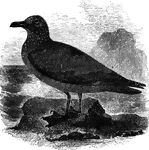
Common Scua
Found throughout Northern Europe, the common skua has been known to attack other birds in order to steal…
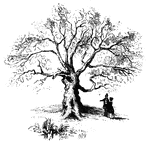
Charter Oak
The Charter Oak. This venerable relic is still virgorous, and is a "gnarled oak" indeed. It stands upon…

Order of the Cincinnati
"Order of the Cincinnati. This was drawn from an original in the possession of Edward Phalon, Esq.,…

Perch skeleton
"The bones of fishes are of a less dense and compact nature than in the higher order of animals; in…




